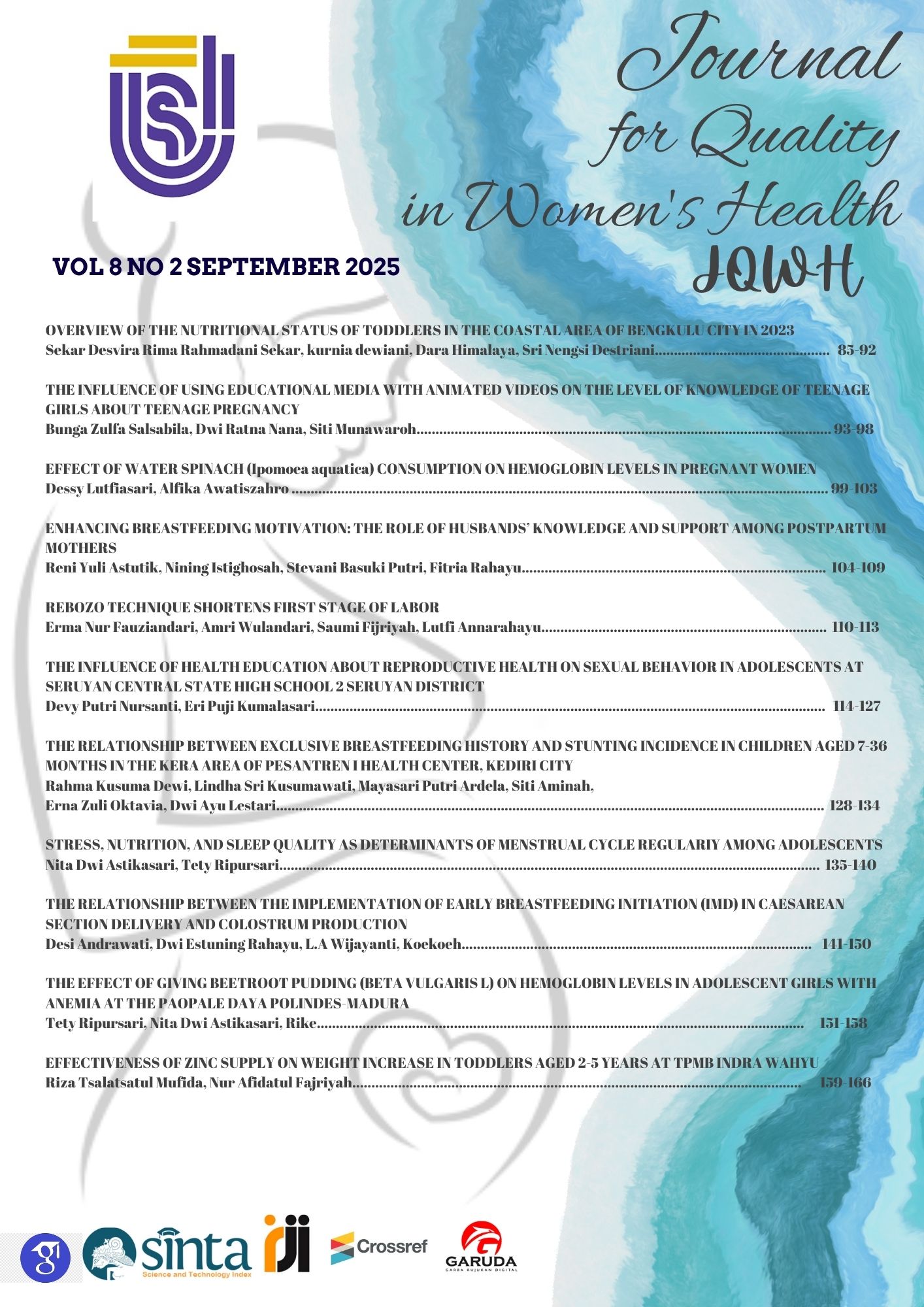THE RELATIONSHIP BETWEEN EXCLUSIVE BREASTFEEDING HISTORY AND STUNTING INCIDENCE IN CHILDREN AGED 7-36 MONTHS IN THE KERA AREA OF PESANTREN I HEALTH CENTER, KEDIRI CITY
DOI:
https://doi.org/10.30994/jqwh.v8i2.277Keywords:
Children Aged 24-59 Months, Incidence, Risk Factors, StuntingAbstract
Stunting results from nutritional deficiencies during pregnancy and early childhood, affecting physical growth and brain development. Maternal, child, and environmental factors contribute to stunting, which can impair physical, cognitive, and motor development, impacting a child's quality of life. This study analyzes the relationship between risk factors and stunting in children aged 24–59 months in Puskesmas Semen, Kediri Regency, in 2023. Using a correlational approach, 189 randomly selected children were analyzed with the Chi-Square test. Low maternal education increased stunting risk (RR 0.3, p < 0.05), while higher education levels were not significant. Non-exclusive breastfeeding (RR 2.9), low birth weight (RR 2.6), short birth length (RR 2.2), and maternal height <150 cm (RR 1.6) were key risk factors. Preventing stunting requires improving maternal education, promoting exclusive breastfeeding, and monitoring birth weight, birth length, and maternal height during pregnancy
References
Baidho, F., Sucihati, F., & Pratama, Y. Y. (2021). Hubungan Tinggi Badan Ibu Dengan Kejadian Stunting Pada Balita usia 0-59 Bulan Di Desa Argodadi Sedayu Bantul. Jurnal Kesehatan Komunitas Indonesia, 17(1).
Damayanti, T., Gunanegara, R. F., & Hidayat, M. (2022). Determinant Factors Associated with Low Birth Weight Babies at Sakit Khusus Ibu dan Anak Kota Bandung From January-December 2019. Journal of Medicine and Health, 4(2), 131-144.
Hadi, H., Fatimatasari, F., Irwanti, W., Kusuma, C., Alfiana, R. D., Asshiddiqi, M. I. N., Nugroho, S., Lewis, E. C., & Gittelsohn, J. (2021). Exclusive Breastfeeding Protects Young Children from Stunting in a Low-Income Population: A Study from Eastern Indonesia. Nutrients, 13(12). https://doi.org/10.3390/nu13124264
Hanifah, I., & Oviyanti, F. (2022). Child cognitive development based on the maternal education. Atfaluna: Journal of Islamic Early Childhood Education, 5(1), 15-24.
Husnaniyah, D., Yulyanti, D., & Rudiansyah, R. (2020). Hubungan tingkat pendidikan ibu dengan kejadian stunting. The Indonesian Journal of Health Science, 12(1), 57-64.
Lukman, T., Anwar, F., Riyadi, H., Harjomidjojo, H., & Martianto, D. (2021). Birth weight and length associated with stunting among children under-five in Indonesia. J Gizi Pangan, 16(1), 99-108.
Putri, Y. R. W., Mulyani, S., & Wiboworini, B. (2024). Relationship of Birth Weight and Birth Length With the Incidence of Stunting Proceedings of the International Conference on Nursing and Health Sciences, Volume 5 No 1, January - June 2024,
Rumingsih, S., Hasbia, H., & Afrika, E. (2022). Hubungan Status Gizi, Bblr Dan Pemberian Asi Ekslusif Dengan Kejadian Stunting Pada Balita Di Puskesmas Mekarsari. PREPOTIF: Jurnal Kesehatan Masyarakat, 6(1), 575-582.
Safaah, N., Yunitasari, E., Efendi, F., Sunanita, S., & Suhartono, S. (2022). Relationship between exclusive breastfeeding and stunting among children aged 2-5 years in Indonesia. Gaceta Medica de Caracas, 130(5S).
Sholeha, A. (2023). Hubungan Tinggi Badan Ibu dengan Kejadian Stunting Pada Anak Usia 24-59 Bulan di Kecamatan Wonomerto Kabupaten Probolinggo Tahun 2022. Healthy Tadulako Journal (Jurnal Kesehatan Tadulako), 9(1), 19-26. https://doi.org/10.22487/htj.v9i1.575
Susyani, S., Febry, F., Margarhety, I., Sadiq, A., Sartono, S., Sari, I. P., & Ni’mah, T. (2022). Maternal risk factor on incidence of stunting in South Sumatera. Open Access Macedonian Journal of Medical Sciences, 10(E), 1599-1604.















